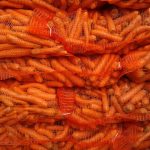Magnetic Food Processing Round-up
Magnetic separation practices are becoming more and more common in the food processing industry, and not only for food and beverages that humans consume. Properly implemented, magnets can save people and animals from ingesting scrap metal or metal dust, which can lead to painful, potentially deadly situations. Naturally, they also keep operational costs down for owners, too. Not only does it cost money to treat a sick animal (let alone a human), but it costs money to fix broken machinery impacted by metal scrap, and not to mention lawsuits.
Metal is one of the most common materials found to affect grain, animal feed, human food, and fish meal, making magnets the best solution for identification and removal. Rare earth magnets — samarium-cobalt and neodymium — are commonly used in food processing because of their strong magnetic field and ability to attract fine contamination, but Alnico is another option as it’s better suited to attract larger metal pieces. Many separator systems for food processing will use both types of magnets, essentially as an insurance policy against unwanted metals.
Types of Magnetic Separators for Animal Feed
There are several specific types of separators that can be applied in a processing system. The first type is a combination of magnetic rods and grates. So, imagine the feed flowing down a chute and through a grated contraption. As the powder, grains, fibers, or liquids move through the grate, small and large metal pieces are attracted to the grates and removed.
Magnetic plates are another option that is useful primarily for things like nails, nuts, bolts, and staples. They can be suspended in chutes, underneath conveyor belts, or beneath pulleys. You can choose between a smooth face plate (recommended for brittle product), pole faceplate (where stronger holding force is required), or tapered face plate (prevents wash-off in high flow applications).
Types of Magnetic Separators in Food and Beverage Industries
Both magnetic grates, rod, and plates can be found in the food and beverage industry for humans as well. Additionally, you might find drawer magnets, hump magnets, and drum type magnets. Drawer magnets are mostly used in applications with gravity flow and dry material. Rare earth magnets capture ferrous particles that are invisible to the naked eye. Staggered rows provide more contact area, and as the product flows over the rows, magnetic tubes attract contaminants.
Hump magnets are commonly made up of two plate magnets mounted in offset housing. As the product enters the housing vertically, it hits the face of the first plate, then moves at an angle to hit the second plate. It’s perfect for high volume, poor flowing, or abrasive material that may need a second pass.
Lastly, magnetic drum separators use a stationary magnetic core and rotating outer shell. As the food or beverage flows over the surface, the magnetic field attracts unwanted scrap and self-cleans by sending it to a discharge area.
Apex Magnets
As you can see, magnets are a great choice if you’re working in the food and beverage industry! We want to help you run your business safely and efficiently, and that means making the right magnetic choices. If you’d like to discuss which types of Apex magnets could be used in a separator, contact us today!

